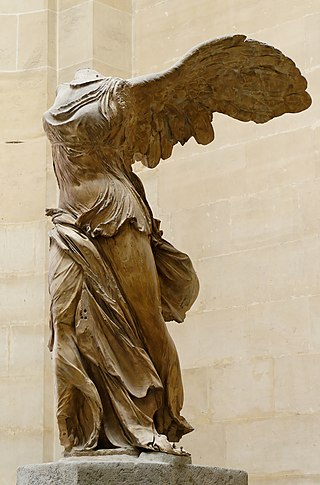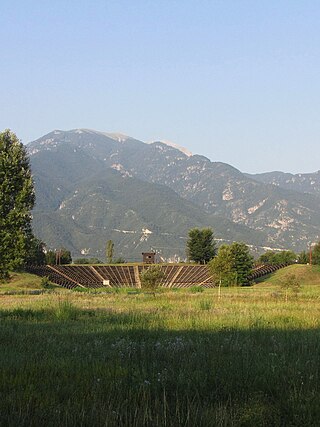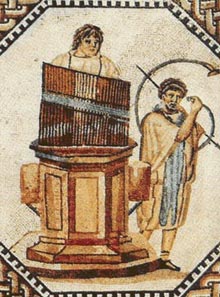
The Dionysus mosaic is the largest preserved mosaic found in excavations in Dion. [1] It shows the epiphany of the triumphant Dionysus.

The Dionysus mosaic is the largest preserved mosaic found in excavations in Dion. [1] It shows the epiphany of the triumphant Dionysus.
The ancient site, with significant excavations and an archaeological museum, is located just outside the modern village of Dion in the Greek region of Central Macedonia in the coastal plain at the foot of Mount Olympus, about 15 km from Katerini and about 17 km from the ancient city of Leivithra.
In the center of the large mosaic, Dionysus is depicted in a chariot. Next to him stands a mature Silenus, who is more a helper of the god than a driver. [2] The carriage is drawn by two panthers, two centaurs hold their reins. One of the two centaurs is a mature, bearded man carrying a vessel (crater) that probably contains wine. The other Kentauer carries on his shoulder a closed vessel in which presumably the sacred symbols of the Dionysus cult are located. The light background highlights the figure of Dionysus.
The mosaic artist used mosaic stones (tesserae) of different sizes and several dozens of shades of color to show details. He thereby gave his work the character of a painting. Surely he was inspired to his work by an important Hellenistic painting.

Of high quality are also the masks under and above the central mosaic. Three on the eastern and three on the western side.
The middle of the three masks of the lower (eastern) side shows Dionysus with long curls. The mask to his left shows a mature satyr with a snub nose.
The mask to the right of him shows a barbarian. The eyes sting, his eyes are lowered. Probably it is Lycurgus, King of Thrace, and an enemy of Dionysus. He pursued the young god, who threw himself into the sea and was saved by Thetis.
The masks above (west) of the Dionysosmosa form a young Satyr on the left and an older Silenius on the right. The mask in between shows the face of a woman with blue eyes and curly hair. This may be the nymph Thetis, the savior of Dionysus.
The central mosaic of the epiphany of Dionysus has the dimensions of 220 cm by 150 cm; The entire mosaic has a floor area of approximately 100 m².
In the summer of 1987 archaeologists found the most important mosaic of the extensive excavation site (As of February 2018 [update] , excavations are still under way). Protected by the covering soil layer it is almost completely preserved.
Of course this precious find had to be protected but should also be accessible to the public. The archaeologists decided to name the place where the mosaic was unearthed "Villa of Dionysus". For over 20 years, the mosaic was sheltered under a roof structure. In order to be able to see the work from all sides, a footbridge was built, on which visitors could orbit it. The roof helped against the rays of the sun, but it was powerless against water and general decay. From year to year the condition became worse: single mosaic stones dissolved from the ground, plants grew in the cracks, it was only a matter of time before this mosaic, which had remained largely intact for nearly two millennia, would be destroyed. [3]

It was decided to create a special building for this work of art. It is located just west of the museum, the Archaiothiki. After completion of the building the mosaic had to be removed from the "Villa of Dionysos". In the fall of 2015, conservators, archaeologists and workers began this project. In order to be able to divide the mosaic into several parts, the position and shape of the individual mosaic stones were first recorded on the intended dividing lines. They were then removed. A special adhesive fabric and textile strips were applied to fix the remaining stones in their place. The mosaic was divided into several, transportable, plates. After that, these plates had to be separated from the underlying ground. At the edge, with long drills, close to each other, holes were drilled into the ground beneath the fixed object. With flat steel blades, which were cut into the holes at certain intervals, experts separated the mosaic from the ground. Then it was carefully raised to allow a suitable steel plate to be driven underneath. The helpers covered the surface with a wooden plate. With several belt tensioners, the plates (steel plate and wooden plate) were fixed against each other so that no movement was possible during transportation. Via a ramp the parts, weighing up to 500 kg, reached a trailer and were transported to the Archaiothiki.
Meanwhile, in the Archaiothiki, a precise image of the entire mosaic was spread on the ground. It was made on a scale of 1:1 to show the restorers where to place each single part. In order to stabilize the mosaic stones, in the next step, the carrier layer under the mosaic was removed and replaced by mortar. With steam, the curators dissolved the special adhesive fabric and removed the attached protective materials. In June 2017 the works had been finished. [4]

The Villa of the Papyri was an ancient Roman villa in Herculaneum, in what is now Ercolano, southern Italy. It is named after its unique library of papyri scrolls, discovered in 1750. The Villa was considered to be one of the most luxurious houses in all of Herculaneum and in the Roman world. Its luxury is shown by its exquisite architecture and by the large number of outstanding works of art discovered, including frescoes, bronzes and marble sculpture which constitute the largest collection of Greek and Roman sculptures ever discovered in a single context.

Dion is a village and municipal unit in the municipality of Dion-Olympos in the Pieria regional unit, Greece. It is located at the foot of Mount Olympus at a distance of 17 km from the capital city of Katerini.

In Greek mythology and religion, the thiasus was the ecstatic retinue of Dionysus, often pictured as inebriated revelers. Many of the myths of Dionysus are connected with his arrival in the form of a procession. The grandest such version was his triumphant return from "India", which influenced symbolic conceptions of the Roman triumph and was narrated in rapturous detail in Nonnus' Dionysiaca. In this procession, Dionysus rides a chariot, often drawn by big cats such as tigers, leopards, or lions, or alternatively elephants or centaurs.

Hadrian's Villa is a UNESCO World Heritage Site comprising the ruins and archaeological remains of a large villa complex built around AD 120 by Roman Emperor Hadrian near Tivoli outside Rome.

The National Roman Museum is a museum, with several branches in separate buildings throughout the city of Rome, Italy. It shows exhibits from the pre- and early history of Rome, with a focus on archaeological findings from the period of Ancient Rome.

The Villa of the Mysteries is a well-preserved suburban ancient Roman villa on the outskirts of Pompeii, southern Italy. It is famous for the series of exquisite frescos in Room 5, which are usually interpreted as showing the initiation of a bride into a Greco-Roman mystery cult. These are now among the best known of the relatively rare survivals of Ancient Roman painting from the 1st century BC.

Hellenistic art is the art of the Hellenistic period generally taken to begin with the death of Alexander the Great in 323 BC and end with the conquest of the Greek world by the Romans, a process well underway by 146 BC, when the Greek mainland was taken, and essentially ending in 30 BC with the conquest of Ptolemaic Egypt following the Battle of Actium. A number of the best-known works of Greek sculpture belong to this period, including Laocoön and His Sons, Venus de Milo, and the Winged Victory of Samothrace. It follows the period of Classical Greek art, while the succeeding Greco-Roman art was very largely a continuation of Hellenistic trends.

The House of the Faun, constructed in the 2nd century BC during the Samnite period, was a grand Hellenistic palace that was framed by peristyle in Pompeii, Italy. The historical significance in this impressive estate is found in the many great pieces of art that were well preserved from the ash of the eruption of Mount Vesuvius in 79 AD. It is one of the most luxurious aristocratic houses from the Roman Republic, and reflects this period better than most archaeological evidence found even in Rome itself.

The Lycurgus Cup is a 4th-century Roman glass cage cup made of a dichroic glass, which shows a different colour depending on whether or not light is passing through it: red when lit from behind and green when lit from in front. It is the only complete Roman glass object made from this type of glass, and the one exhibiting the most impressive change in colour; it has been described as "the most spectacular glass of the period, fittingly decorated, which we know to have existed".

The over-lifesize marble Dionysus with Panther and Satyr in the Palazzo Altemps, Rome, is a Roman work of the 2nd century AD, found in the 16th century on the Quirinal Hill at the time foundations were being dug for Palazzo Mattei at Quattro Fontane. The statue was purchased for the Ludovisi collection, where it was first displayed in front of the Palazzo Grande, the main structure of the Villa Ludovisi, and by 1641 in the gallery of sculptures in the Casino Capponi erected for Cardinal Ludovico Ludovisi in the villa's extensive grounds. By 1885, it had been removed to the new Palazzo del Principe di Piombino, nearby in via Veneto. With the rest of the Boncompagni-Ludovisi collection, which was open to the public on Sundays and covered in the guidebooks, and where it had become famous, it was purchased in 1901 for the City of Rome, as the Ludovisi collection was dispersed and the Villa's ground built over at the end of the 19th century.

The Archaeological Museum of Dion is a museum in Dion in the Pieria regional unit of Central Macedonia, Greece.

In late Classical Greek art, ichthyocentaurs were centaurine sea beings with the upper body of a human, the lower anterior half and fore-legs of a horse, and the tailed half of a fish. The earliest example dates to the 2nd century B. C., among the friezes in the Pergamon Altar. There are further examples of Aphros and/or Bythos, the personifications of foam and abyss, respectively, depicted as ichthyocentaurs in mosaics and sculptures.

Stabiae was an ancient city situated near the modern town of Castellammare di Stabia and approximately 4.5 km southwest of Pompeii. Like Pompeii, and being only 16 km (9.9 mi) from Mount Vesuvius, this seaside resort was largely buried by tephra ash in 79 AD eruption of Mount Vesuvius, in this case at a shallower depth of up to 5 m.

A Roman mosaic is a mosaic made during the Roman period, throughout the Roman Republic and later Empire. Mosaics were used in a variety of private and public buildings, on both floors and walls, though they competed with cheaper frescos for the latter. They were highly influenced by earlier and contemporary Hellenistic Greek mosaics, and often included famous figures from history and mythology, such as Alexander the Great in the Alexander Mosaic.

The Archaeological Museum of Pella is a museum in Pella in the Pella regional unit of Central Macedonia. The building was designed by architect Kostas Skroumpellos and is on the site of the ancient city of Pella. It was completed in 2009 with the support of the Greece's Third Community Support Framework.

The Villa Romana del Tellaro is a large, elaborate Roman villa dating from the late Roman Empire.

The Archaeological Park of Dion is the most important archaeological site at Mount Olympus in Greece, located in Dion. In the area comprised by the Archaeological Park of Dion, sanctuaries were found from the Hellenistic and Roman periods. The park displays the importance of ancient Dion in the history of Pieria.

The largest building of the Archaeological Park of Dion in northern Greece is the Hellenistic-era theatre. It is located in the south of the village of Dion, Pieria and is often used during the summer for performances of the Olympus Festival.

The Hydraulis of Dion Greek: Ύδραυλις του Δίου; romanized: Ídravlis tou Díou) is a unique exhibit of the Archaeological Museum of Dion. It is the earliest archeological example of a pipe organ to date.

Archaeological and historical finds, as well as contemporary works of art are displayed in the museums and exhibitions at Mount Olympus.